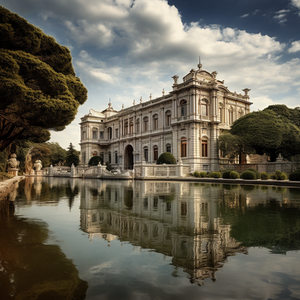Hadiqat al-Nakhil: Difference between revisions
(Created page with "{{Shirerithian article}} {{Infobox building |name = Hadiqat al-Nakhil |native_name = حديقة النخيل |former_names = |image = Hadiqat al-Nakhil.png |image_size = 300px |caption = |map_type = |altitude = |building_type = Palace |architectural_style = Baroque, Rococo and neoclassical styles |structural_system = |cost = |location...") |
No edit summary |
||
| Line 45: | Line 45: | ||
The palace is built in an eclectic style of elements from the Baroque, Rococo and neoclassical styles, mixed with traditional [[Çakaristan|Çakari]] architecture to form a new synthesis. The exterior shows a classical [[Benacia|Benacian]] two-winged arrangement divided by a large central risalite with two corner risalites. | The palace is built in an eclectic style of elements from the Baroque, Rococo and neoclassical styles, mixed with traditional [[Çakaristan|Çakari]] architecture to form a new synthesis. The exterior shows a classical [[Benacia|Benacian]] two-winged arrangement divided by a large central risalite with two corner risalites. | ||
The palace is roughly composed of three parts: the ''Salam Hall'' (Babhki: تالار سلام), the welcome hall and associated rooms for the reception of guests | The palace is roughly composed of three parts: the ''Salam Hall'' (Babhki: تالار سلام), the welcome hall and associated rooms for the reception of guests; the ''State House'' (Babhki: خانه حالت), the quarters containing meeting rooms and offices for the Shahanshah and state officials; and the ''Mutlaqa'' (Babkhi: موتلفه), the private quarters of the Shahanshah and his family. | ||
There are rumours that the palace would also have a Hammam (Babkhi: حمام), a bathhouse, but this has not been confirmed. The rumour arises from the huge amount of soil that was removed during the renovation, which indicates that the palace was undercrofted. Also, a bathhouse was a regular feature of a [[House of Vinandy|Vinandy]] residence in the [[Francia|Frankish]] period. | There are rumours that the palace would also have a Hammam (Babkhi: حمام), a bathhouse, but this has not been confirmed. The rumour arises from the huge amount of soil that was removed during the renovation, which indicates that the palace was undercrofted. Also, a bathhouse was a regular feature of a [[House of Vinandy|Vinandy]] residence in the [[Francia|Frankish]] period. | ||
Latest revision as of 19:31, 6 November 2023
| Hadiqat al-Nakhil | |
حديقة النخيل | |
 | |
| General information | |
|---|---|
| Type | Palace |
| Architectural style | Baroque, Rococo and neoclassical styles |
| Location | Shirekeep |
| Current tenants | Hakim bin Alsalam and his family |
| Inaugurated | 1726 AN |
| Owner | House of Alsalam |
The Hadiqat al-Nakhil (Arboric: حديقة النخيل) is a palace in the Shirerian capital Shirekeep. It was purchased by Hakim bin Alsalam (Jaaguzan, Shahanshah of Çakaristan) in 1722 AN.
After restoring inheritance rights, Hakim bin Alsalam bought the palace, only to have it renovated. The building was in poor condition and almost uninhabitable. The renovation took four years and was completed just in time when the Shahanshah's state visit to Shireroth took place. The palace was named "Hadiqat al-Nakhil", meaning 'garden of palms'.
Design and layout
The palace is built in an eclectic style of elements from the Baroque, Rococo and neoclassical styles, mixed with traditional Çakari architecture to form a new synthesis. The exterior shows a classical Benacian two-winged arrangement divided by a large central risalite with two corner risalites.
The palace is roughly composed of three parts: the Salam Hall (Babhki: تالار سلام), the welcome hall and associated rooms for the reception of guests; the State House (Babhki: خانه حالت), the quarters containing meeting rooms and offices for the Shahanshah and state officials; and the Mutlaqa (Babkhi: موتلفه), the private quarters of the Shahanshah and his family.
There are rumours that the palace would also have a Hammam (Babkhi: حمام), a bathhouse, but this has not been confirmed. The rumour arises from the huge amount of soil that was removed during the renovation, which indicates that the palace was undercrofted. Also, a bathhouse was a regular feature of a Vinandy residence in the Frankish period.
The garden contains a pond surrounded by a wide variety of trees and shrubs. In particular, palms, from which the palace takes its name.